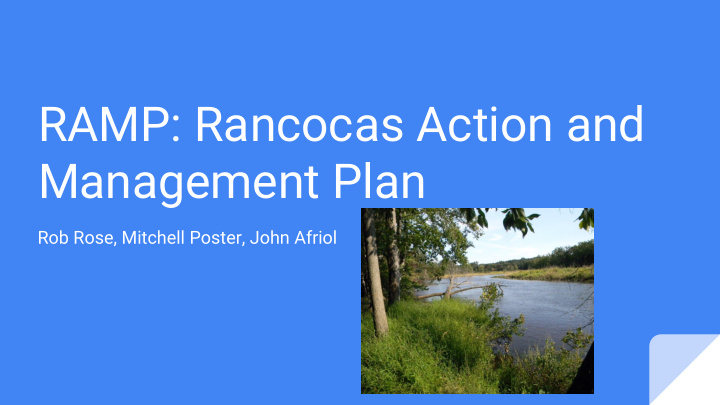



RAMP: Rancocas Action and Management Plan Rob Rose, Mitchell Poster, John Afriol
Overview - Mission Statement - Watershed Characteristics - Land Use - History and Governance - Problems - Goals - Conclusions
Mission Statement Develop and implement a watershed management plan that enhances the water quality of the Rancocas Creek Watershed to ensure that it is fishable, swimmable, and potable, and to support native populations of flora and fauna by year 2030.
Watershed Characterization - Covers 360 square miles in west- central New Jersey - Lies within portions of Burlington (primary), Camden, and Ocean Counties - Contains 33 municipalities - Part of the Lower Delaware water region
Watershed Characterization - Divided into the North Branch, Greenwood Branch, South Branch, Southwest Branch, and the Main Stem - Flows into the Delaware River - Two-thirds of the RCW lie within the Pinelands National Preserve - About 75% of the PNR portion of the watershed is undeveloped forest, and the rest of this area is developed or farmed - Development outside of the PNR is more varied and intense
Land Use - Forested Lands (40%) - Agriculture (30%) - Cranberry and Blueberry Farming - Urban Lands (17%)
Land Use - Pineland National Reserve portions comprised primarily (~75%) by Upland Forest and Wetlands - Greenwood Branch ~90% Upland Forest/Wetland Agriculture (low pH and specific conductance typical of unaltered pinelands basins) - Southwest Branch has highest levels of development, followed by the South and North Branches (elevated pH and specific conductance)
Land Use
Recreation and Wildlife - Recreational Activities include hiking, fishing, kayaking, canoeing, and bird watching - Painted and box turtles, herons and kingfishers, and white-tailed deer - Some trees that live in the watershed include maple, hickory, and oak
History/Government - European settlement brought towns and industries to the pines in the seventeenth century, landscape began to change - Congress created the Pinelands National Reserve (PNR) through the National Parks and Recreation Act of 1978 - In 1979, New Jersey formed a partnership with the federal government to preserve, protect, and enhance its land’s resources
History/Government Cont. - In early 1990s, Pinelands Commission initiated long term environmental monitoring - In 1998, the Public Advisory Committee (PAC) of the Rancocas Creek Watershed was issued a grant of $550,000 to produce base base maps and GIS layers, education and outreach materials, and other action plans
Problems in Rancocas Creek Watershed - Elevated pH and dissolved solids downstream of developed and agricultural areas - Disruption of native populations of plants and animals and introduction of exotic species in degraded areas of watershed is linked to elevated pH and dissolved solids (Greatest occurrence of non-native species in areas of greatest development) - Increased levels of fecal coliform bacteria and phosphorous
Sources of Contaminants 1. Failing Septic Systems 2. Agricultural Runoff 3. Residential Runoff 4. Wildlife 5. Commercial and Industrial Stormwater Management 6. Managed Turf
Objectives and Strategies Strategy: Educate local officials regarding watershed issues, Objective: Improve and maintain water develop model ordinances to improve and encourage stormwater management retrofits. Encourage stormwater quality infiltration and retrofits, develop model ordinances to improve water supply and encourage water preservation. Objective: Support healthy populations Strategy: Normalize pH to naturally occurring levels through of native plants and animals while regulation of agriculture, stormwater management, reduction of impervious cover. discouraging exotic populations Strategy: Conduct a buffer gap assessment, revegetate buffers, Objective: Reduce fecal coliform levels locate septic tank pollution.
Conclusion - Pollution from agriculture and development degrading the quality of the water - The health of the Rancocas Creek Watershed must be improved to support native flora and fauna and to maintain the quality of the watershed’s various recreational resources - It is important that we preserve the integrity of the watershed by limiting development in critical areas. - Remember, RAMP it up
Thanks for listening! Questions?
Sources "THE RANCOCAS CREEK BASIN." New Jersey. Pinelands Commission, 2003. Web. 2016. <http://www.nj.gov/pinelands/infor/reports/Rancocas%20Final%20Report.pdf>. "What We DO?" Rancocas Conservancy. N.p., n.d. Web. 2016. <http://www.rancocasconservancy.org/what-we-do/>. "Watershed Management Area 19 Rancocas." New Jersey. N.p., n.d. Web. 2016. <http://www.nj.gov/dep/watershedrestoration/wma19_info.html>. "Clean and Plentiful Water: A Managament Plan for the Rancocas Creek Watershed." N.p., 2003. Web. 2016. <http://www.co.burlington.nj.us/DocumentCenter/Home/View/189>. "Rancocas Watershed Study: Pesticides in the Creek." The Native Plant Society of New Jersey. N.p., 2003. Web. 2016. <http://www.npsnj.org/articles/rancocas_watershed_study. html>. "Rancocas Creek Greenway Implementation Plan for the Main Stem." N.p., 1996. Web. 2016. <http://www.dvrpc.org/reports/96021.pdf>. New Jersey Pinelands Commission | The Pinelands National Reserve." New Jersey Pinelands Commission | The Pinelands National Reserve . N.p., n.d. Web. 04 Apr. 2016. <http: //www.nj.gov/pinelands/reserve/>. Community Public Water Supply." Coliform Bacteria Fact Sheet . N.p., n.d. Web. 04 Apr. 2016. <http://www.health.state.mn.us/divs/eh/water/factsheet/com/coliform.html>.
Recommend
More recommend